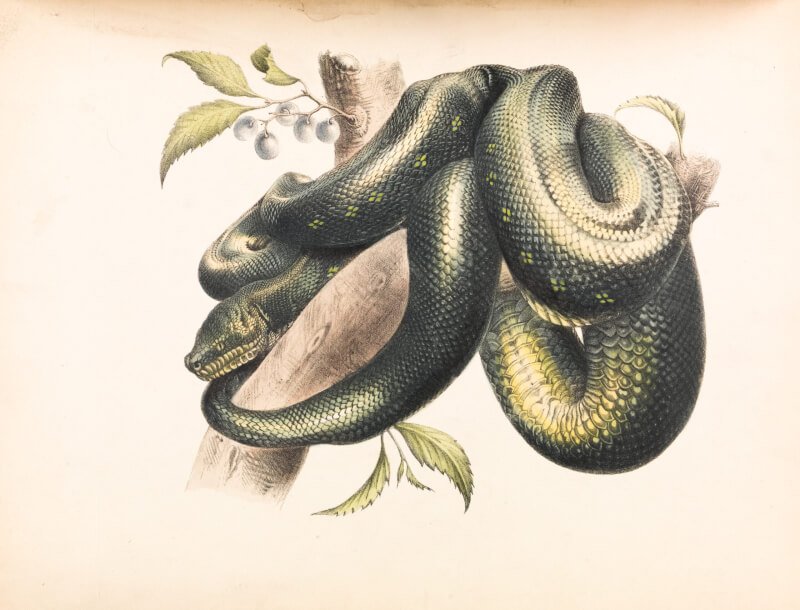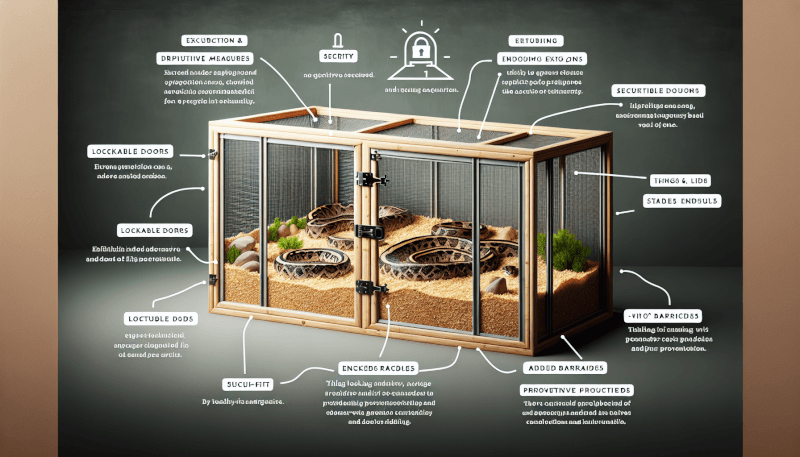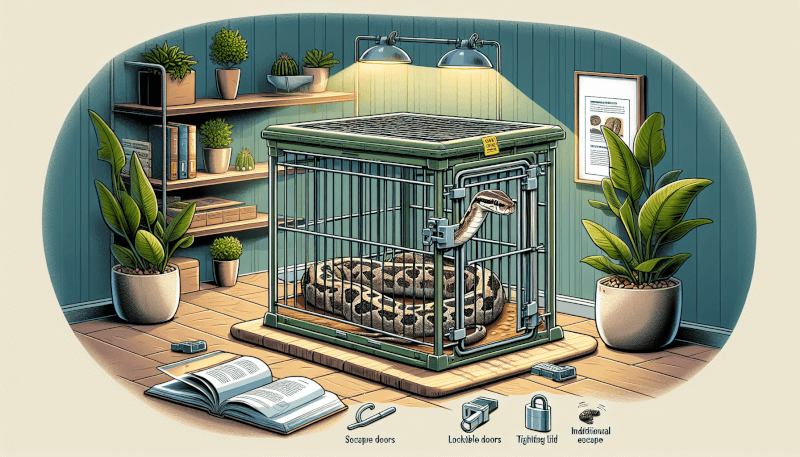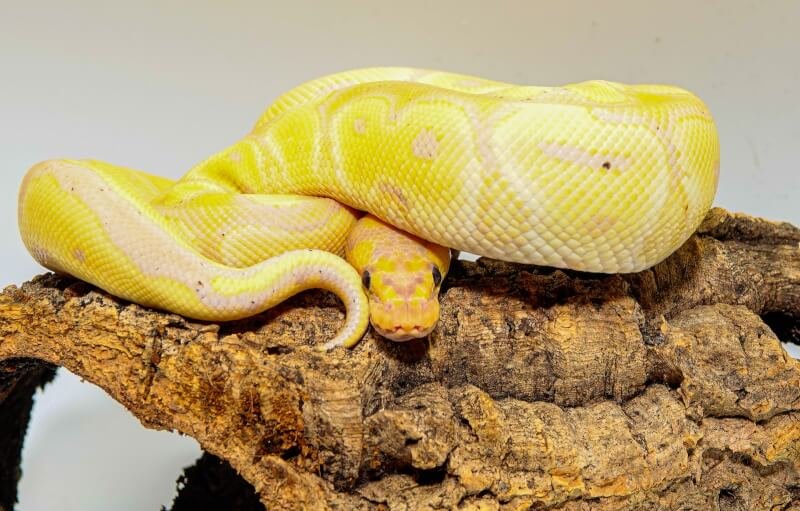So you’ve got a pet snake, and you want to make sure it stays safe and secure in its enclosure. Nobody wants a surprise slithering visitor in their living room! Luckily, there are a few simple yet effective measures you can take to prevent your sneaky serpent from making a great escape. From ensuring a snug fit for the enclosure’s lid to eliminating any gaps or holes that could serve as an escape route, this article will provide you with the best ways to keep your snake right where it belongs.
Choosing the Right Enclosure
When it comes to choosing the right enclosure for your snake, there are a few crucial factors to consider. First and foremost, the size of the enclosure should be adequate for your snake’s needs. Snakes require enough space to move, stretch, and explore, so it’s important to choose an enclosure that allows them to do so comfortably.
Additionally, the structure of the enclosure should be secure. Snakes are notorious escape artists, and if there are any weak points or gaps in the enclosure, they will find them. Look for enclosures that are built with sturdy materials and have reinforced seams to prevent any potential weaknesses.
Finally, the enclosure should have an escape-proof lid. Snakes are skilled climbers, so it’s important to choose a lid that they can’t easily slide or push open. Look for lids that securely lock in place, preventing your snake from lifting or prying them open.
Enclosure Placement
Once you have the perfect enclosure for your snake, it’s important to consider its placement within your home. First and foremost, make sure the enclosure is placed on stable ground. Uneven surfaces or wobbly stands can lead to accidents or even tip the enclosure over, creating a potential escape route for your snake.
It’s also crucial to place the enclosure away from high-traffic areas in your home. Loud noises, sudden movements, and constant disturbances can stress out your snake, increasing the likelihood of escape attempts. Choose a quiet and relatively undisturbed area where your snake can feel safe and secure.
Proper ventilation is another important aspect to consider when placing your snake’s enclosure. Snakes require fresh air to thrive, so make sure the enclosure has proper ventilation to ensure a healthy and comfortable environment for your pet.

Secure Enclosure Features
Even with the perfect enclosure and placement, there are additional features you can consider to further secure your snake’s enclosure. One essential feature is tight-fitting doors. Make sure the doors of the enclosure close tightly and securely to prevent any gaps or openings that your snake can exploit.
Locking mechanisms can also provide an extra layer of security. Look for enclosures that come with built-in locking mechanisms, or consider adding locks or clips to ensure that your snake cannot accidentally or intentionally open the enclosure.
Escape-proof vents are another feature to consider. Snakes are adept at squeezing through small openings, so make sure the vents on the enclosure are designed to prevent any escape attempts. Look for vents with narrow gaps or consider using mesh screens to cover the vents and prevent your snake from slipping through.
Sealing Potential Escape Routes
Even the most secure enclosure can have small gaps or crevices that your snake can exploit. It’s important to regularly inspect the enclosure for any potential escape routes and take steps to seal them. Covering gaps and crevices with sealant or tape can help prevent your snake from finding a way out.
Similarly, sealing any holes or vents in the enclosure can eliminate potential escape routes. Snakes have a remarkable ability to contort their bodies and fit through small openings, so make sure all holes and vents are properly sealed to prevent any escape attempts.
In some cases, adding an escape-proof barrier around the enclosure can provide an extra level of security. This can be done by placing a barrier, such as a strip of smooth plastic or metal, around the base of the enclosure to prevent your snake from getting a grip and climbing out.

Monitor Regularly
Regular monitoring is key to preventing escapes and ensuring the safety of your snake. Conducting visual inspections of the enclosure on a regular basis allows you to identify any potential weak points or damage that could lead to an escape. Regularly check the sealant, locks, and vents for any signs of wear or damage.
In addition to visual inspections, consider using security cameras to monitor your snake’s enclosure. This can provide you with real-time footage and alerts, allowing you to quickly respond to any escape attempts. Some cameras even come with motion detection capabilities, making it easier to detect any unusual activity.
Maintaining an escape log can also be beneficial. Keep a record of any incidents or attempts, including the date, time, and any relevant information. This log can help you identify any patterns or recurring issues, allowing you to take appropriate measures to prevent future escapes.
Psychological Enrichment
Creating a mentally stimulating environment for your snake can help prevent escape attempts motivated by boredom or stress. Providing hiding spots, such as caves or tunnels, allows your snake to feel secure and mimic their natural behavior.
Climbing structures are another great addition to your snake’s enclosure. Snakes are natural climbers, and providing branches, logs, or other climbing surfaces can keep them engaged and satisfied within their enclosure.
Implementing environmental changes, such as rearranging decorations or adding new objects, can provide mental stimulation and keep your snake entertained. Snakes are curious animals, and introducing new elements can prevent boredom and reduce the likelihood of escape attempts.

Handling and Feeding Practices
Proper handling techniques are not only important for your snake’s safety, but also for preventing escape attempts. Snakes can become easily startled or stressed when mishandled, which can lead to escape attempts. Educate yourself on the proper way to handle your snake and always approach them calmly and confidently.
Creating a secure feeding area is another crucial consideration. Feeding your snake inside their enclosure can sometimes result in messy situations, which can compromise the security of the enclosure. Consider using a separate feeding container to minimize the risk of escape during feeding time.
Avoid overfeeding your snake as well. Snakes that are overly full and lethargic may be more prone to escape attempts as they seek out cooler or more secluded areas for digestion. Stick to a proper feeding schedule and monitor your snake’s weight to ensure they are in a healthy range.
Education and Awareness
Understanding snake behavior is essential for preventing escapes. Snakes have specific environmental and behavioral needs, and meeting these needs can reduce stress and minimize the desire to escape. Educate yourself on the specific requirements of your snake species and ensure that their enclosure is designed to meet those needs.
Knowing the signs of discontent is also crucial. Snakes may display behaviors such as excessive pacing, rubbing their noses against the enclosure, or repeatedly trying to escape. Recognizing these signs can help you identify and address any potential issues before escape attempts occur.
Educating others who interact with your snake is equally important. Make sure friends, family members, or anyone else who may have contact with your snake understands the proper handling techniques, potential dangers, and the importance of maintaining a secure enclosure.

Emergency Preparedness
No matter how diligent you are in preventing escapes, it’s always important to have a plan in case an escape does occur. Having a snake escape plan involves knowing the steps to take and having the necessary equipment on hand to safely capture your snake.
Maintaining a list of emergency contacts is also crucial. Keep a list of local reptile experts, veterinarians, or snake handlers who can provide assistance in case of an escape or emergency situation. Having these contacts readily available can save valuable time and ensure a quick and safe resolution.
Consider using microchips or tags to identify your snake. While not foolproof, these identification methods can help increase the chances of a lost snake being returned to you. Consult with a veterinarian or local reptile expert to determine the best identification option for your snake.
Addressing Escapes Promptly
If your snake does manage to escape, it’s important to take immediate action. Time is of the essence, as the longer your snake is loose, the greater the chances of it becoming injured or lost. Conduct a thorough search of your home, paying close attention to warm and dark areas where your snake may seek refuge.
Blocking access points can help prevent your snake from venturing even further from its enclosure. Seal off any openings or gaps that your snake may have used to escape, ensuring that all potential escape routes are securely closed.
Resorting to scent tracking can also be an effective method for locating your snake. Snakes have a highly developed sense of smell, so placing items with your scent or the scent of your snake’s preferred prey near potential hiding spots can help guide your snake back to its enclosure.
In conclusion, preventing escapes from your snake’s enclosure requires careful consideration of the enclosure itself, as well as its placement and security features. Regular monitoring, psychological enrichment, proper handling and feeding practices, education and awareness, emergency preparedness, and prompt action in the event of an escape are all vital components of a comprehensive escape prevention plan. By following these guidelines, you can provide a safe and secure environment for your snake, reducing the risk of escapes and ensuring the well-being of your pet.


